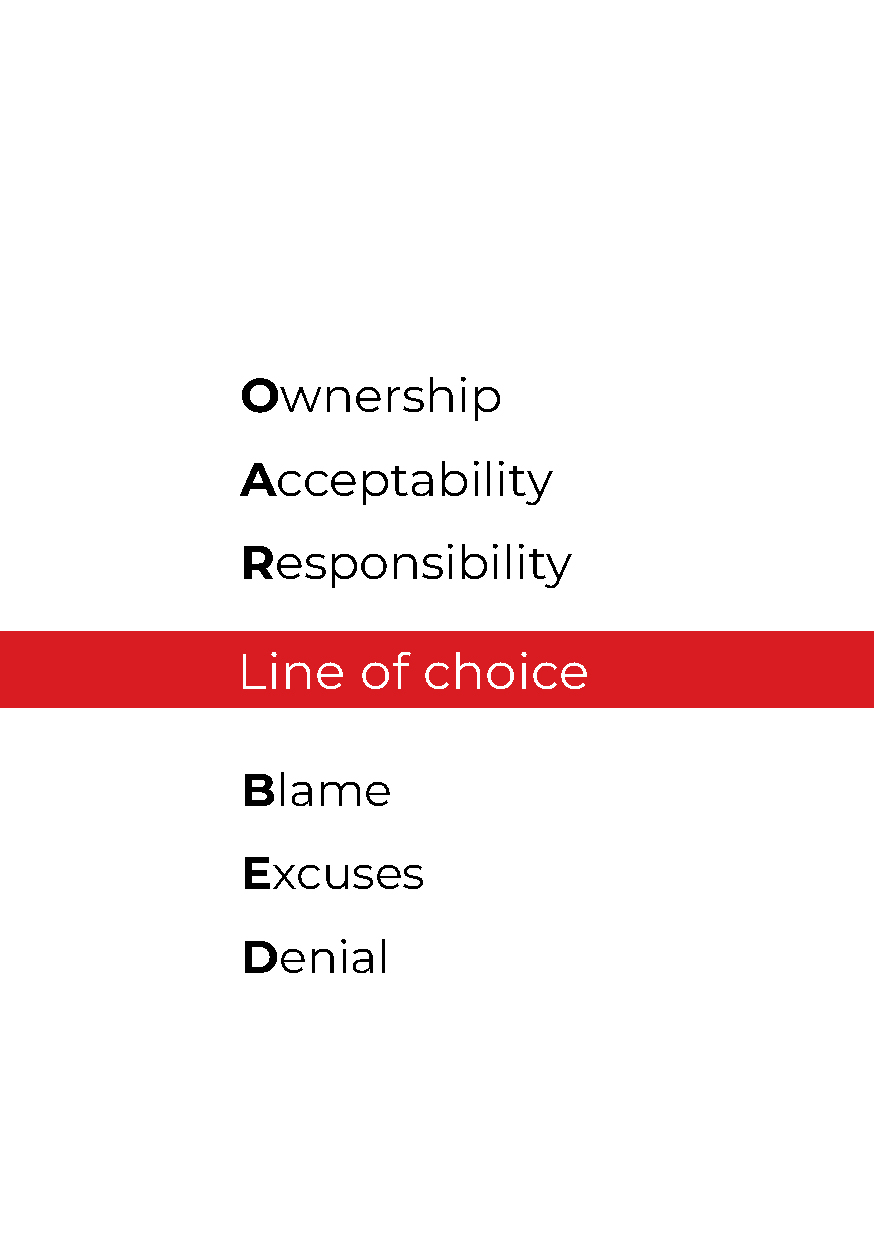Have you ever struggled to get your team to take ownership of their work?
Many leaders grapple with fostering a culture of accountability within their teams. The Line of Choice is an impactful tool for leaders and organisations to measure both where you sit, and where your team and organisation sit in terms of acceptability/accountability, ownership, and responsibility. Let’s explore how to stay above the line of choice and achieve better results.
Suzi Finkelstein, Senior Facilitator at Women & Leadership Australia, explains The Line of Choice and shares her insights for leaders.
What is Above the Line Behaviour?
Above the Line behaviour can be summarised with the acronym – OAR.
OAR: Ownership, Acceptability/Accountability and Responsibility
Individuals and teams who sit Above the Line are usually in an environment where they as a team and as individuals are happy to accept and be responsible for the outcomes they produce – not just the excellent ones, but the not so good ones as well. In these environments, colleagues usually experience a high level of psychological safety and can work collaboratively with each other.
Examples of Above the Line Behaviours
- Sam misses a deadline and she apologise to the team, acknowledging the impact it had on the team and commits to rectifying the effect the missed deadline had. She might say: “Sorry I didn’t get that done. I know this is going to adversely affect the project, I will support the team until we’re back on track”.
- During a software product launch, a bug slips through testing and impacts a small portion of users. David, the developer who wrote the affected code section, immediately informs the team lead and takes full responsibility for the error. He proactively proposes solutions and works diligently to fix the bug and release a patch as quickly as possible.
In both examples, the team member feels comfortable in their team and organisation to take personal responsibility. For this to happen, your team must feel supported and psychologically safe in the workplace. An employee or team who feels they are not valued, that they are in a precarious position in the workplace or that they are not well-liked by their team or manager is far less likely to feel able to demonstrate above the line behaviour and take personal responsibility for their actions.
What does it mean to be Below the Line?
Below the Line thinking usually manifests itself in organisations with cultural issues, where teams or individuals don’t feel comfortable, or don’t want, to accept shared or singular responsibility for the outcomes they produce. There is a lack of willingness to take personal responsibility. This is particularly true where the outcome is less than desirable. It is also understandable: as Brene Brown explains, ‘blame is the discharging of discomfort and pain’ by putting it on to another person.
Below the Line behaviour can be summarised with the acronym – BED.
BED: Blame, Excuses, Denial
Examples of Below the Line behaviours
- Louise is working on a group project and hasn’t completed her assigned section by the deadline. When questioned, she claims she wasn’t aware of the deadline and blames poor communication from the group leader. This is an example of avoiding responsibility by shifting the blame to someone else.
- Joe is a customer service representative. He receives a complaint from a customer, instead of trying to resolve it himself he passes the customer on to another colleague because his shift is about to finish.
Where do you sit on the line of choice?
Identifying where you sit on the line of choice involves connecting with your fellow colleagues to determine where they see your position on the line. The recommendation is to start with individuals with whom you have a close relationship and gradually extend the conversations to others in the workplace, including supervisors and colleagues from different teams.
This process allows you to receive feedback more openly from those you trust and feel psychologically safe around. The focus should be on identifying one aspect to work on in the next 30 days and actively working towards improvement. Understanding where you are perceived to be on the line is crucial for personal and professional development.
How to stay above the line of choice
One of the most important things you can do as a leader to encourage Above the Line behaviour is to demonstrate it yourself. Acknowledging imperfection, including your own, is paramount. Accepting accountability and taking ownership are challenging yet essential aspects of leadership. Your role is to foster an environment where individuals and teams feel empowered to represent these behaviours. Provide support through guidance and resources, and express appreciation for their efforts in demonstrating accountability and responsibility.
Identify below the line behaviours
Spotting unproductive Below the Line behaviours can help you address them. These behaviours often fall into patterns such as blaming others, making excuses, or denial of an issue.
For instance, during a project review, someone might say, “It would have gone better if I had more support from X team.” This is a way of deflecting responsibility.
In such situations, encourage everyone to take ownership. Ask questions that shift the focus to solutions, like “What can we do differently next time to improve collaboration?” or “How can we better involve all teams in the future?”
Promoting a Culture of Accountability
The Line of Choice provides a valuable framework for assessing where you and your team stand in terms of accountability, ownership, and responsibility.
It’s important to acknowledge that everyone falls below the line sometimes. Leading by example and actively reaching out to support team members who consistently display Below the Line behaviours can really help to bring the entire team Above the Line.
Remember, creating a psychologically safe environment where every team member feels valued and respected is key to promoting a culture of accountability and enabling personal and professional growth.
So, take the first step in identifying where you stand on the Line of Choice, and commit to continuous improvement for yourself and your team to help you all stay above the line of choice.



